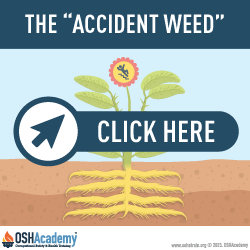Accident Scenario
Step 5. Determine the Causes
After developing the sequences of events, the next step is to determine surface causes.
This step can be challenging. First, you have to identify the surface causes of the accident in each step, which may take time. Once you have those clues, you can then identify the system weaknesses or root causes.
Refer to the "accident weed" infographic.
Surface Causes — are represented by leaves on the weed. They are the unique hazardous conditions and individual unsafe or inappropriate behaviors. There are two categories of surface causes: primary and secondary.
- Primary surface causes are the immediate unique conditions or individual behaviors that cause accidents. Examples of unique primary surface causes of accidents include:
- an unguarded grinder
- a defective respirator
- a floor hole
- Contributing surface causes are the unique conditions and behaviors that indirectly contribute to, but do not cause the accident. Unique contributing surface causes include:
- removing the guard on a grinder
- failure to test a respirator
- a hole in the floor is not properly covered
Root Causes — are represented by the roots of the weed. Root causes pre-exist the surface causes of accidents. They contribute to the unique hazardous conditions and unsafe work practices. Remember, the performance of a safety management system is a function of its design. Therefore, analyze the following two categories of root causes: design and performance.
- Design root causes are those SMS policies, programs, plans, processes, and procedures that are missing or inadequately designed. For instance, if the training doesn't cover the use of Personal Protective Equipment (PPE), then the SMS is not properly designed. System root cause design weaknesses include:
- absence of written safety responsibilities for supervisors and managers
- lack of a formal safety training plan
- no formal scheduled safety inspection plan or procedures
- Performance root causes are management actions (behaviors) that somehow contribute to accidents. For example, when supervisors fail to conduct safety inspections, the performance of the SMS is flawed. System root cause performance weaknesses include:
- supervisors and managers failing to execute their safety responsibilities
- safety orientation, initial training, or retraining is not being conducted
- supervisors, employees, and safety committees are not conducting safety inspections
Knowledge Check Choose the best answer for the question.
6-8. Supervisors failing to regularly conduct scheduled safety inspections would be considered a _____.
You forgot to answer the question!

